Understanding delayed planting decisions in Michigan
Reviewing the options available to producers who have not yet planted their field crops because of poor planting conditions.

For agricultural producers this spring has been filled with uncertainty. Due to cold and wet conditions, many Michigan producers have not been able to plant their corn and soybeans. Each time it rains, the delay is prolonged. As we move into June important deadlines are quickly approaching where farmers must decide if they are going to plant their intended crop, file a prevented planting claim on their crop insurance, or plant a different crop.
The situation
This spring has been cooler with more precipitation than normal. For example, Kalamazoo has received approximately10 inches of rain since April 1, nearly 3 inches more than the 5 year average according to MSU Enviroweather. Furthermore, according to the June 3, 2019 Crop Progress report released by the U.S. Department of Agriculture (USDA) National Agricultural Statistics Service (NASS) nearly all of Michigan’s topsoil and subsoil has adequate or surplus moisture with 69 and 59 percent of Michigan’s topsoil and subsoil, having surplus moisture. In addition to excess moisture, cooler temperatures have also impacted planting. According to MSU Enviroweather, many parts of the state are a week to 14 days behind on growing degree days (days above 50°F compared to normal).
Given this excessive moisture, farmers have not been able to work their fields because the equipment would get stuck, some fields are underwater, and in the long term driving on saturated soils can cause soil compaction problems. Since the soils are so saturated, multiple days of no rain, sunshine and breeze are needed so the fields can dry. The Crop Progress release, reported there were only 2.2 days the week ending June 2 that would have allowed for fieldwork, and only 2.5 days the previous week.
So how bad is the situation? According to the Crop Progress report, as of June 2, only 42 percent of Michigan’s projected 2,350,000 corn acres have been planted – nowhere near the 5 year average of 87 percent. Nationwide usually 96 percent of the U.S. corn crop has been planted by this time, however, only 67 percent has been planted thus far in 2019. Surrounding states like Illinois (45 percent), Indiana (31 percent) and Ohio (33 percent) are in similar or even worse situations.
Soybeans are in an analogous situation, however, the planting season is later than corn. By June 2, 31 percent of Michigan’s 2,200,000 soybean acres have been planted, up 8 percentage points from May 26. However, the 5 year average for this time of year is 73 percent. For the 18 states that produce 95 percent of U.S. soybeans, 39 percent of intended acres have been planted, compared to the 5 year average of 79 percent.
Another wrinkle
As if the uncertainty from the weather wasn’t enough, additional uncertainty is coming from policy and international trade. The 2019 Market Facilitation Program (MFP), which the government said should not influence plantings is in fact being considered in producers decisions to plant. As of this date, payments from the Market Facilitation Program are tied to actual planted acres, thus producers who may have opted to not plant and take the prevented planting payment from their corn crop insurance (more later), may decide to plant instead. Furthermore, trade uncertainty with China and African swine fever has recently driven down soybean prices.
The pending Ad Hoc Disaster Assistance in the Supplemental Appropriations Bill may also become a factor. However, it has not yet passed Congress and seems to not be applicable to the Midwest region.
Producers’ decision making process
Fortunately, farmers have access to crop insurance through the Federal Crop Insurance Corporation administered through the USDA’s Risk Management Agency. In the 2018 crop year, Michigan farmers purchased crop insurance for approximately 64 percent of intended corn for grain and silage acres and 73 percent of intended soybean acres according to the USDA’s risk management agency.
Given the poor planting conditions, producers who have a Revenue Protection or Yield Protection crop insurance policy have alternatives on how to proceed. Producers currently need to decide if they are going to plant the intended crop, plant the crop late with reduced coverage, take a prevented planting claim, or potentially plant another crop. Producers need to be in contact with their crop insurance agent to make sure they understand the details of their specific contract and pending options.
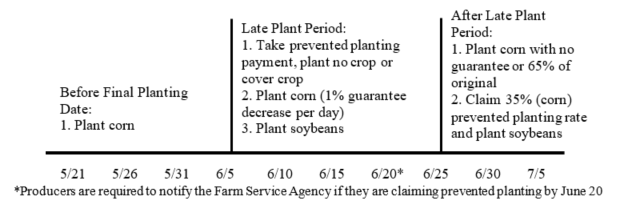
Figure 1 describes the current timeline and decisions available to corn producers. There are three distinct periods set for crop insurance: 1) Before final planting date 2) Late plant period and 3) After late plant period. In Michigan the final plant date is June 5 for corn and June 15 for soybeans. For corn the late plant period is June 6 to June 25, and June 16 to July 10 for soybeans. There are different options available to producers during each period. For illustration we will use corn. Producers should discuss these options with their crop insurance agent.
Before or on the final planting date (before June 6) producers can plant corn if they are able and receive full crop insurance coverage.
During the late planting period from June 6 to June 25, for corn, there are three options available to producers:
- Take prevented planting payment and either plant no crop or plant a cover crop which is not harvested/hayed/grazed before November 1. The formula to calculate the Prevented Planting Payment= payment factor × coverage level x Actual Production History × spring projected price. For our example= 55% payment factor × 80% coverage level x 160 bu/acre Actual Production History × $4.00/bu project price=$281.60/acre. Note, producers have 72 hours to inform their crop insurance agent of this decision. The maximum acres eligible for prevented planting is the maximum acres planted in corn during the last 4 years in the insurable unit (adjusted for acreage increases) minus the corn planted thus far in 2019. However, prevented planting acres need to be at least 20 acres or 20% of total acres (smaller of two) for each “crop insurance unit.” It is imperative to pay attention to these requirements for each unit. Note that wet areas, headlands, and edges of fields can be used to meet the minimum acreage requirements.
- Plant corn with 1% reduction in coverage per day. No prevented planting payment will be received.
- Plant soybeans or another crop. No prevented planting payment will be received. Note, a 1% guarantee discount per day will be incurred for soybeans planted on or after June 16 (during soybean late plant period).
After Late Plant Period (after June 25 for corn) there are two main options:
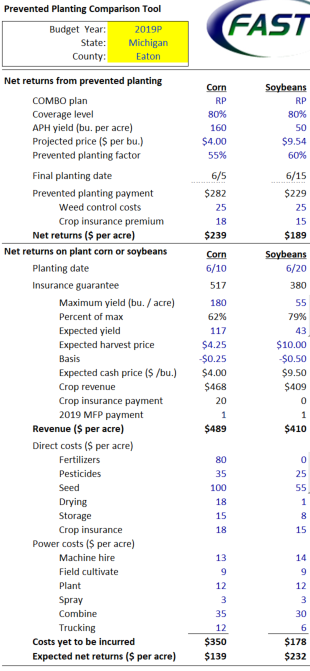
- Plant corn with no crop insurance guarantee or 65% of original guarantee.
- Claim 35% of the prevented planting payment for corn (only pay 35% of premium) and plant soybeans (considered first crop soybeans). Michigan is not a double crop state. Producers interested in this option are highly encouraged to speak with their crop insurance agent. During the late planting period for soybeans the 1% per day guarantee discount will be applied. Furthermore, your APH for corn will be reduced.
Fortunately, economists at the University of Illinois FarmDoc Daily have designed a tool to aid producers with this decision. Their FAST prevented planting comparison tool is available at https://farmdoc.illinois.edu/fast-tools/planting-decision-model. Figure 2 shows output for a hypothetical farm in Eaton County, MI which is trying to make this decision. This hypothetical producer has 80 percent coverage in a revenue protection COMBO plan.
This is a partial budgeting exercise to evaluate the different options. Note the option to claim 35 percent of the prevented planting payment for corn and plant soybeans is not shown in the tool. The returns shown are the returns to fixed costs (i.e., land rents or mortgage, equipment loans, etc.), since those costs will need to be paid even if no crops are planted. In the direct costs and power costs sections, one should only enter costs that have not yet been incurred. If you have already applied soybean fertilizer, for example, then this is a sunk cost and $0 would be entered into the tool. Based on the assumptions entered (including the planting date), the farmer would earn the highest net return by taking the prevented planting payout from their crop insurance for corn.
Note, this is for one set of assumptions. Thus, it is imperative to work through multiple potential scenarios to see how the optimal decision changes with the assumptions entered. These tools are only as accurate as the information entered. Fortunately, the farmDoc tool provides a sensitivity table for different price and yield combinations (see figures 3 and 4).
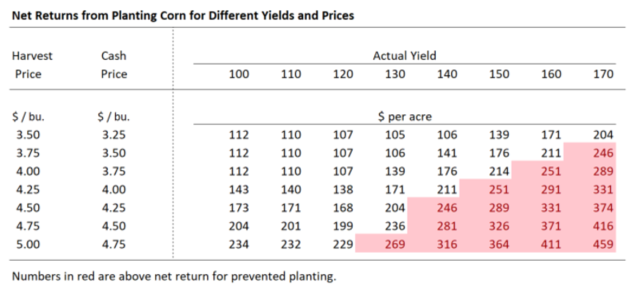
When interpreting the results the red shaded areas have a higher return for planting the crop than taking the prevented planting payment. However, other sensitivities regarding plant date, MFP payments, and other factors should also be conducted. For example, test the program with later planting dates and reduced potential yields.
Consider the risks and rewards. Study the sensitivity tables to see how much down side risk there is with varying prices and yields compared to upside potential with higher yields and prices. How likely are these different scenarios? As we move into the late planting season, most will shift towards taking the prevented planting claim.
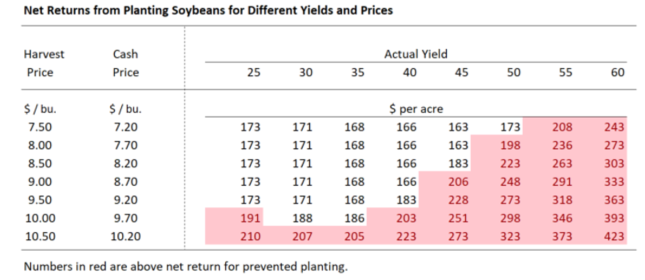
Note that prevented planting returns for corn are typically higher per acre than prevented planting payouts for soybeans. Therefore, of the prevented planting acres claimed, producers will want to maximize corn acres.
These tools are not the be-all and end-all in the decision of whether to plant corn, soybeans, or take a crop insurance payout. Other factors should be considered in the decision making process. For example, future APH yield calculations, and potential loss of enterprise unit classification should be considered. For example, a farm can lose their enterprise unit classification and discount for their 2019 premiums if they do not plant at least 20 acres or 20 percent of total acres (whichever is less) in those units that qualify for the enterprise units premium discount.
Furthermore, the decision does not need to be for the whole farm or all farms. Potentially the prevented payment could be claimed for 50 percent of the acres, while corn is planted on the remaining acres on June 6, with a 1 percent reduction in coverage level.
Producers who are making this decision are encouraged to read the farmdocDaily article titled “Weekly Farm Economics: Prevented Planting, 2019 Market Facilitation Program Payments, Disaster Assistance, and Price Dynamics” from May 29, 2019.
How common are prevented planting claims?
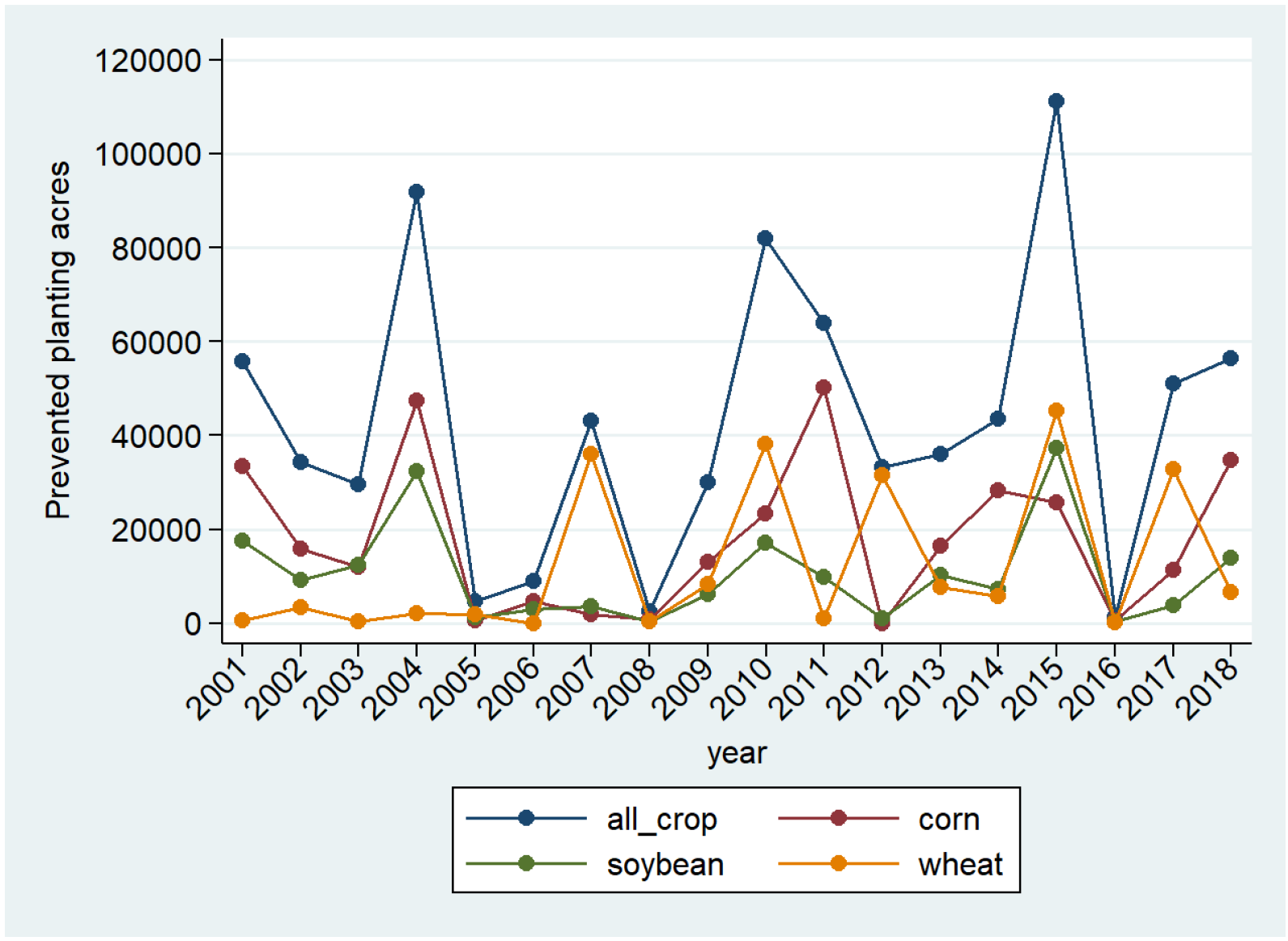
Figures 5 and 6 detail historical claims for prevented planting acres from 2001 to 2018 for Michigan and the U.S. For the majority of the years since 2001, less than 20,000 intended corn acres had prevented planting claims in Michigan (Figure 5). The most claims were made in 2004 and 2011, around 50,000 acres. Soybean acres with prevent planted claims were also under 20,000 acres for most years, with the largest number of claims in 2004 and 2015. Nationally, the most prevented plant claims for corn and soybeans were made in 2011, 2013, and 2015 (Figure 6).
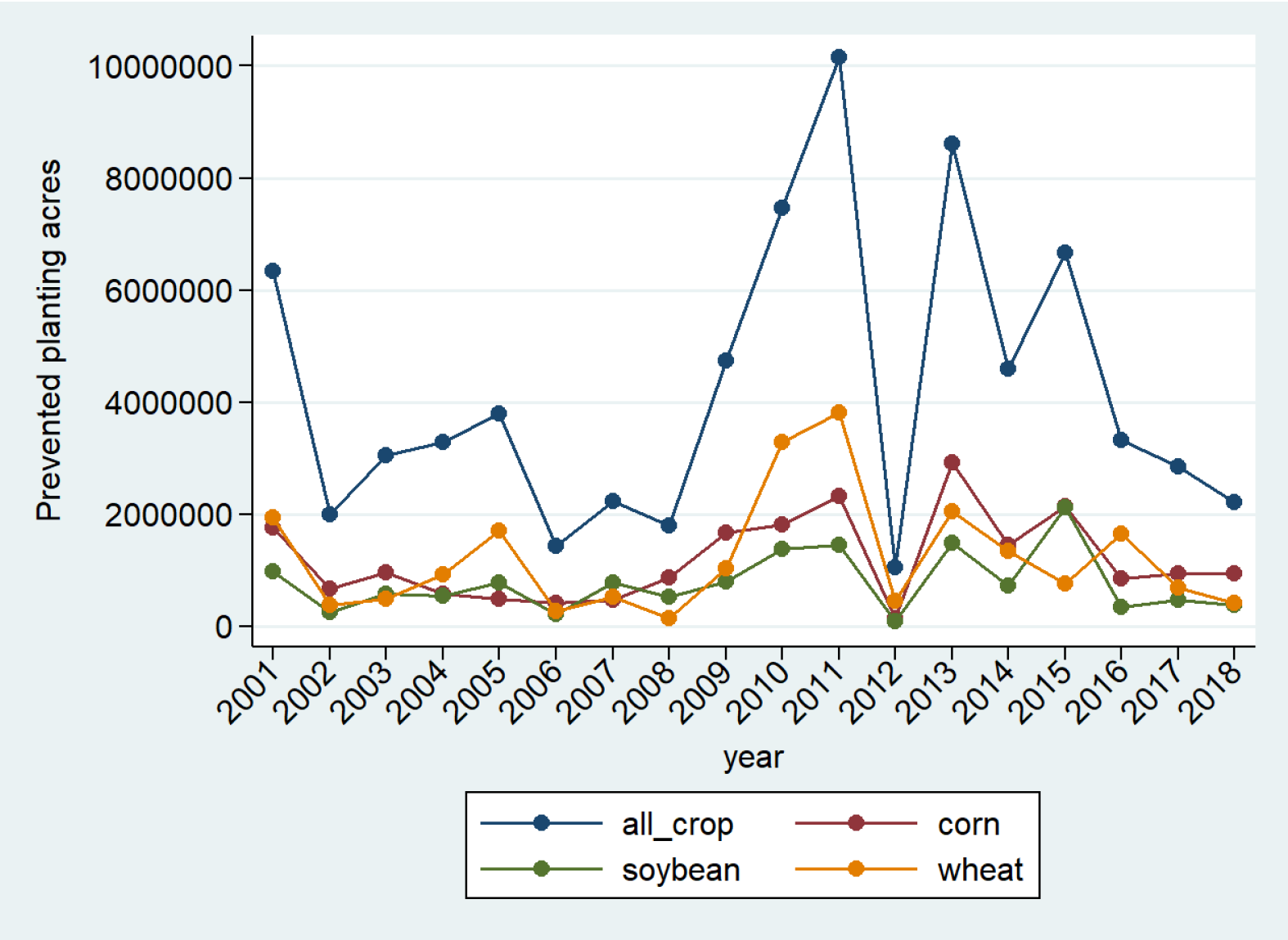
Given that Michigan still has over half of its corn and soybean acres left to plant, 2019 could potentially see historically high prevented planting claims. If claims are made on 4 percent of the remaining corn acres to be planted then 2019 claims would surpass 2011 claim volume. Similarly, if claims are made on 3 percent of remaining soybean acres then 2019 would surpass 2015 claim volume.
How can you help?
What can you do to encourage your local farmer? When you see them, don’t ask how they are doing (the answer is not good), but instead offer a word of encouragement. When you see a tractor on the road, don’t be impatient. If close friends or family are farmers, offer to pick their kids up from school or take them to soccer practice. Most simply, just a smile and a thank you go a long way. Finally, give them some grace – can you imagine if your livelihood depended on such uncontrollable factors?
MSU Extension offers additional educational resources and programs to help farmers as they deal with delayed planting seasons at https://www.canr.msu.edu/agriculture/delayed-planting-resources.



 Print
Print Email
Email